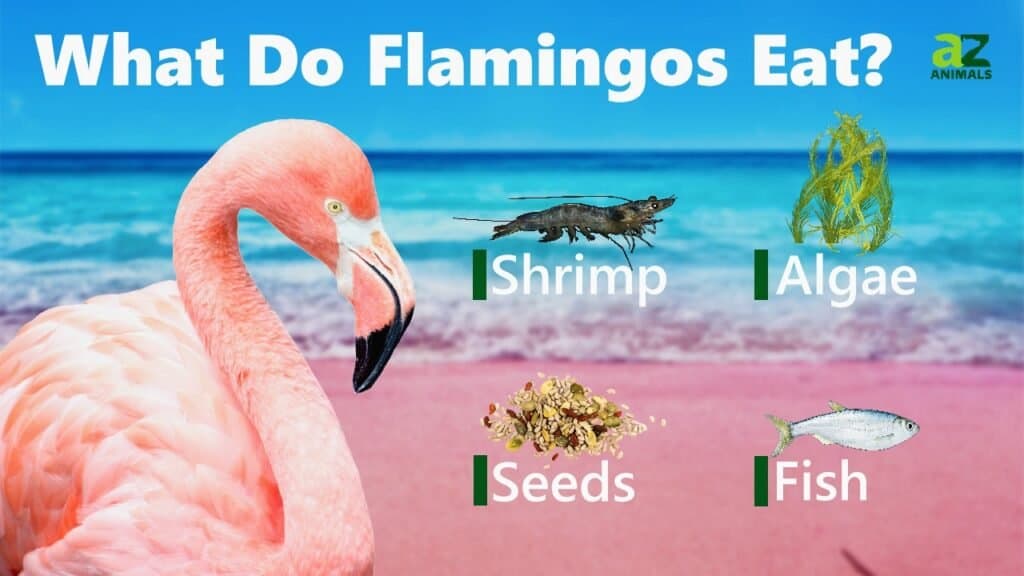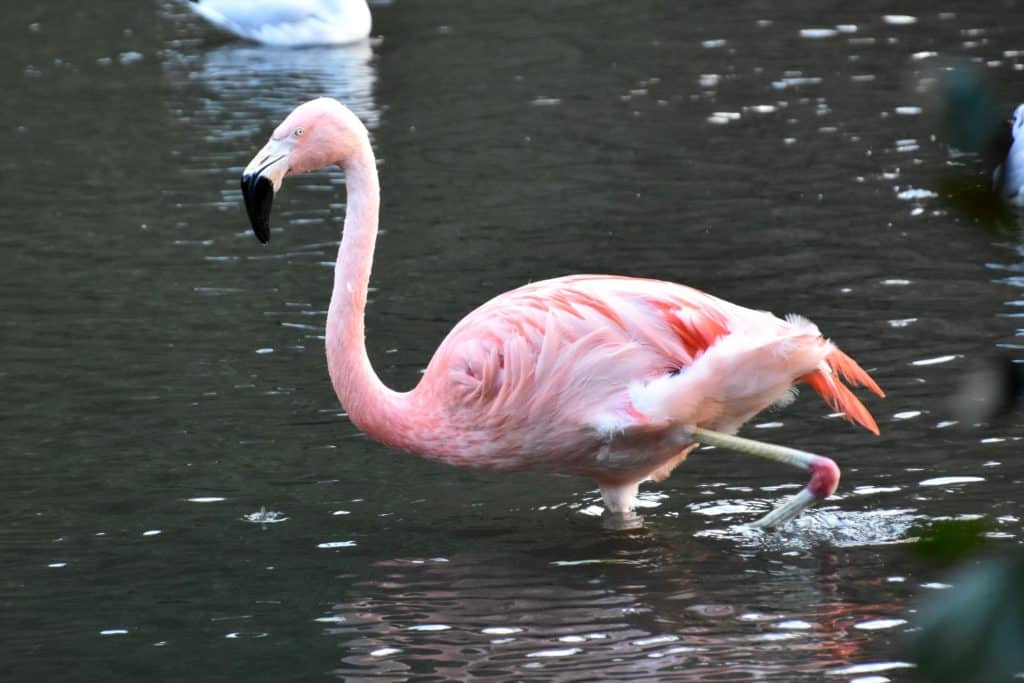Did you know that if you eat too many carrots, your skin will actually turn into a carrot-orange color? This happens because carrots contain a certain pigment called carotenoid. Carrots aren’t the only food that contain carotenoid. Foods like brine shrimp and even some algae such as diatoms contain this pigment. These foods, which flamingos eat, are what give them their color.
Flamingos that eat algae are colored a deeper orange shade than those that eat the animals that feed on the algae, such as brine shrimp. Since these birds which stand on one leg are so largely defined by what they eat, it’s quite normal to wonder how they eat, especially considering their beaks. Do flamingos have a set of sparkling white teeth hidden behind their orange-black beaks?
Do Flamingos Have Teeth?

Flamingos, like all birds, do not have teeth.
©Natalia Barsukova/Shutterstock.com
When flamingos search for food, they wad through shallow water or around their mud nests with their webbed feet. They step onto the mud with their webbed feet, which helps to bring their food to the surface. Flamingos are omnivores, which means that they feed on plants and animals. They primarily eat algae or brine shrimp but also eat other things like seeds and fly larvae. These animals have a broad diet but manage it all without any teeth.
Birds do not have teeth, and flamingos are no different. However, swallowing too-large food bits can cause them to choke, so flamingos have varying tactics they use to ensure that doesn’t happen. They peck their foods into tiny bits, suitable for digestion, but this isn’t an efficient strategy for marine meals such as shrimp and algae. Consequently, they practice filter feeding like many fishes. Flamingos are able to do all of these with the help of their beaks.
Flamingo Beaks

Although flamingos’ beaks aren’t upside down, they seem so because of their shape. Most birds have their upper beak larger than their bottom one, but this is not the case with all flamingo species. It is believed that flamingos once had “normal” beak types, which evolved to adapt better to their surroundings and prey.
Scientists believe this because various flamingo species have varying beak types, specialized to help them feed on the type of prey found around their habitats. So, you might wonder, “just how do flamingos eat with their beaks?” Well, when they filter feed, they use their tongues as pumps to suck water in and push it out. They also have comb-like plates on the edge of their beaks and tongues called lamellae.
With their heads upside down, they duck their heads beneath the water with their beaks pointed to their webbed feet. Then, using impressive skill, flamingos swing their heads from side to side with open beaks and suck in insects, algae, and other prey with their tongues. Then, they close their beaks and push the water out with their tongues.
The comb-like plates function as gates or a sieve, allowing the water out but keeping the food in. They also keep out food too large for the flamingo.
Are Flamingos Born with Beaks?
Baby flamingos or chicklets are born with beaks, but their beaks aren’t formed enough to enable them to feed like adult flamingos. Their beaks are usually straight, so they cannot filter feed like their parents. Hence, parent flamingos have to feed their babies with something called crop milk.
Crop milk is a liquid substance with more levels of protein and fat than human or cow milk. It is produced by both male and female flamingos and is bright red, which makes it look a lot like blood. Flamingos secrete crop milk in their esophagus.
Both parent flamingos produce crop milk, so they take turns feeding their young. The bright red color of their crop milk is caused by their coloring and contributes to giving the baby flamingo the pink or orange color.
However, this feeding affects parent-flamingos. They start to lose their pink or orange color and look a little dull and washed out – not too different from human parenting! However, parent flamingos continue to do this until their children can feed themselves.
Flamingo Jaws
Flamingos’ have lower and upper jaws. The lower parts are fixed to the heads and do not move, while the upper jaws move and can be controlled. When flamingos eat, they raise their upper jaw and beak, which is the opposite of what humans do. When we eat, we drop our jaws.
However, when flamingos turn their heads upside down and feed, they drop their upper jaws, making it similar to how humans eat. These majestic birds can control their beaks due to the placement of “large oval masses of erectile tissue”, per Ohio University.
These tissue masses are placed on both sides of the floor or the base of the flamingo’s mouth. Scientists suspect that these erectile tissues also help flamingos eat but haven’t been able to explain it fully.
Can Flamingos Bite?

Flamingos can peck with their beaks.
©Millie Bond – Copyright A-Z Animals
Although flamingos do not have teeth, it doesn’t stop them from pecking. They use their beaks to peck and bite if they need to. While they do not have teeth, their beaks have sharp lamellae that can injure and scratch.
Flamingos are usually calm and peaceful animals but will not hesitate to protect themselves if they are harassed or feel threatened. They are known to attack humans for this reason.
Did Birds Have Teeth in the Past?
Although birds do not have teeth now, it’s natural to wonder if they ever did. Surprisingly, scientists suggest they did and even have some information and facts to prove this theory. The most prominent of these is a CT scan carried out on the skull of the ancient bird called Ichthyornis.
The Ichthyornis lived about 100 million years ago and had beaks that functioned as tongs or pincers. The bird, more similar to a modern-day gull, also had a set of teeth inherited from the archaeopteryx, its dinosaur ancestor, per a 1977 study.
Up Next:
Flamingo Poop: Everything You’ve Ever Wanted to Know
The photo featured at the top of this post is © iStock.com/YULIIA LAKEIENKO
Sources
- Reid Park Zoo, Available here: https://reidparkzoo.org/blog/flamingos-use-their-beaks-to-filter-their-food/
- , Available here: https://web.stanford.edu/group/stanfordbirds/text/essays/Flamingo_Feeding.html
- Smithsonian's National Zoo & Conservation Biology Institute, Available here: https://nationalzoo.si.edu/animals/news/why-are-flamingos-pink-and-other-flamingo-facts
- National Library of Medicine, Available here: https://pubmed.ncbi.nlm.nih.gov/17738415/
Thank you for reading! Have some feedback for us? Contact the AZ Animals editorial team.






